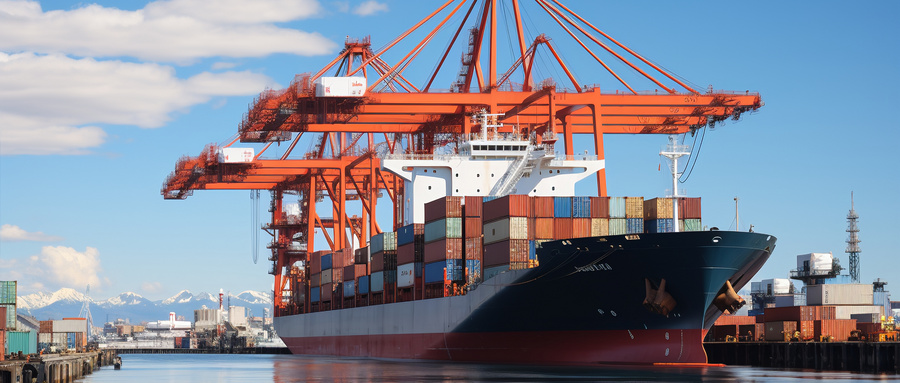

For the second week in a row, freight rates on the US-West route fell across the board
Affected by the new capacity, the Shanghai export container freight index fell for two consecutive weeks, and the ocean-going routes in Europe and the United States declined comprehensively, especially the western line of the United States fell significantly. The industry believes that the freight rate correction is related to the increase in capacity, and it is expected that the freight rate will still decline but the decline will narrow next week. At the same time, the delivery of new ships increased significantly in the first half of the year, and more capacity was delivered in the second half of the year, intensifying market competition.
Analysts in the international logistics industry pointed out that after a period of sharp rise in freight rates, there will naturally be a correction phenomenon, and the Red Sea crisis and the expiration of labor contracts on the East coast of the United States at the end of the year are important keys to affecting the market. In addition, some shipping companies chose to deploy small vessels to the US-West route to compete for supplies, which further increased the supply of capacity and had a significant impact on the performance of freight rates in the past two weeks.
Senior executives of freight forwarders and shipping companies also revealed that with the increase of overtime sailings and the continuous launch of new routes, the freight rate of the US-West route has fallen from the peak of $8,500 on July 1 to the current range of $6,700 to $6,900. At the same time, the freight rate of the US-East route has also dropped from the peak of $10,400 to about $9,800. It is expected that market freight rates will continue to decline next week, but the decline will be narrowed.
According to Alphaliner's statistics, 271 new ships were delivered worldwide in the first half of the year, with a total capacity of 1.68 million TEU, of which the second quarter was the peak of deliveries, with an average of 315,000 TEU delivered per month. As of now, the total global capacity has reached 30.266 million TEU, setting successive record highs. A further 1.49 million TEU of new capacity is expected to be delivered in the second half.
Freight forwarding industry insiders stressed that the high freight rates of European and American routes attracted a large number of overtime vessels into the market, and the launch of new route services to compete for cargo sources, which are the main reasons for the decline in freight rates. Among them, due to the high turnover rate of ships, the US-West route has become the hardest hit area, and the spot market price has fallen to 6 words, with a cumulative decline of more than 1,000 US dollars.
Even if the freight rate is loose, the SCFI freight index fell for two consecutive years, a total decline of only 191.36 points, 5.13%, compared with the 13 consecutive weeks of growth from early April to early July, and 1.03 times the increase, the shipping company is still very profitable.
SCFI's latest Freight Index:
Shanghai to Europe freight rate of 5000 US dollars /TEU, down 51 US dollars, down 1.01% week;
Shanghai to the Mediterranean freight rate of 5,361 US dollars /TEU, down 63 US dollars, weekly decline of 1.16%;
Shanghai to the United States freight 7124 US dollars /FEU, down 530 US dollars, a weekly decline of 6.92%;
Shanghai to the United States East freight 9751 US dollars /FEU, a small drop of 130 US dollars, a weekly drop of 1.32%.
Persian Gulf line per box freight of $2,193, down $80, or 3.52%;
South American line (Santos) freight of $8,212 per box, down $548, or 6.26%;
In terms of the oceanic line, the Far East to Japan's Kansai and Kanto are $293 and $299, the same as last week; The Far East to Southeast Asia was $711 per TEU, down $42, or 5.57%; From the Far East to Korea, the price rose by $3 per TEU to $165.

Analysts in the international logistics industry pointed out that after a period of sharp rise in freight rates, there will naturally be a correction phenomenon, and the Red Sea crisis and the expiration of labor contracts on the East coast of the United States at the end of the year are important keys to affecting the market. In addition, some shipping companies chose to deploy small vessels to the US-West route to compete for supplies, which further increased the supply of capacity and had a significant impact on the performance of freight rates in the past two weeks.
Senior executives of freight forwarders and shipping companies also revealed that with the increase of overtime sailings and the continuous launch of new routes, the freight rate of the US-West route has fallen from the peak of $8,500 on July 1 to the current range of $6,700 to $6,900. At the same time, the freight rate of the US-East route has also dropped from the peak of $10,400 to about $9,800. It is expected that market freight rates will continue to decline next week, but the decline will be narrowed.
According to Alphaliner's statistics, 271 new ships were delivered worldwide in the first half of the year, with a total capacity of 1.68 million TEU, of which the second quarter was the peak of deliveries, with an average of 315,000 TEU delivered per month. As of now, the total global capacity has reached 30.266 million TEU, setting successive record highs. A further 1.49 million TEU of new capacity is expected to be delivered in the second half.
Freight forwarding industry insiders stressed that the high freight rates of European and American routes attracted a large number of overtime vessels into the market, and the launch of new route services to compete for cargo sources, which are the main reasons for the decline in freight rates. Among them, due to the high turnover rate of ships, the US-West route has become the hardest hit area, and the spot market price has fallen to 6 words, with a cumulative decline of more than 1,000 US dollars.
Even if the freight rate is loose, the SCFI freight index fell for two consecutive years, a total decline of only 191.36 points, 5.13%, compared with the 13 consecutive weeks of growth from early April to early July, and 1.03 times the increase, the shipping company is still very profitable.
SCFI's latest Freight Index:
Shanghai to Europe freight rate of 5000 US dollars /TEU, down 51 US dollars, down 1.01% week;
Shanghai to the Mediterranean freight rate of 5,361 US dollars /TEU, down 63 US dollars, weekly decline of 1.16%;
Shanghai to the United States freight 7124 US dollars /FEU, down 530 US dollars, a weekly decline of 6.92%;
Shanghai to the United States East freight 9751 US dollars /FEU, a small drop of 130 US dollars, a weekly drop of 1.32%.
Persian Gulf line per box freight of $2,193, down $80, or 3.52%;
South American line (Santos) freight of $8,212 per box, down $548, or 6.26%;
In terms of the oceanic line, the Far East to Japan's Kansai and Kanto are $293 and $299, the same as last week; The Far East to Southeast Asia was $711 per TEU, down $42, or 5.57%; From the Far East to Korea, the price rose by $3 per TEU to $165.





